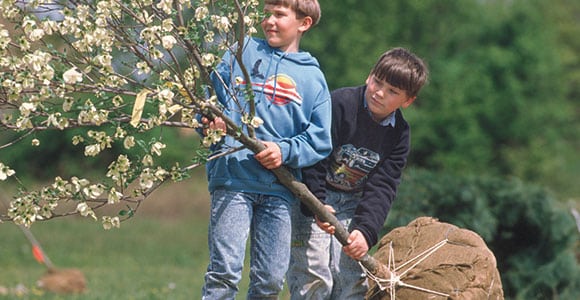Want to save money on your energy bill without investing in expensive retrofits and renovations? Get a shovel. Strategically planting trees and shrubs around your home is a tried-and-true way to save.
Energy savings gained from shade trees depend on the location and orientation of both the trees and the house. Your climate also comes into play. But smart landscaping can generally shave about 25 percent of energy used for cooling and heating.
In summer months, a tree’s shade cools the surrounding air temperatures by as much as 9 degrees. Air temperatures directly under trees can be as much as 25 degrees cooler. This means that a homeowner can reduce an unshaded home’s summer air-conditioning costs by 15 percent to 50 percent.
In the winter, trees and shrubs block heavy winds. Homeowners are encouraged to plant deciduous trees if possible. Unlike evergreens, these trees lose leaves in the winter and allow more sunlight into the home for natural warmth.
For details on using trees to save energy, the U.S. Department of Energy’s Energy Efficiency and Renewable Energy website has thorough discussions of the benefits of shading on its Landscape Shading Energy Savers page (http://energy.gov/public-services/homes/landscaping). A detailed (though dated) consumer guide, “Landscaping for Energy Efficiency,” is also available: www1.eere.energy.gov/library/pdfs/16632.pdf.
Not all tree shading plans will realize savings. Shading the coils of an air-conditioning unit has the potential to modestly reduce energy demand. But if done improperly, there could be a net increase in energy use. Researchers from the Florida Solar Energy Center found that effective shading of an AC unit could yield energy savings of 6 percent, but improper setup could result in a drop in efficiency of up to 15 percent. This efficiency erosion happens when the vegetation blocks proper airflow to the unit or traps too much heat near the unit.
Planting trees and shrubs near a heating-and-cooling system requires constant monitoring. During the growing season, plants can creep closer to the system and interfere with proper air circulation.
While trees and shrubs are often employed to thwart the efforts of nosy neighbors, they have other practical functions. Through the carefully planned positioning of vegetation, homeowners can realize significant savings on their home energy bills. Research the best plants to use, and consider how and where they will grow before letting anything take root. Make a practical investment in tree shading. It’s a decision that will grow on you.
Thomas Kirk is a program manager specializing in energy efficiency and renewable energy for the Cooperative Research Network, a service of the Arlington, Va.-based National Rural Electric Cooperative Association. The Cooperative Research Network monitors, evaluates and applies technologies that help electric cooperatives control costs, increase productivity and enhance service to their consumers.




